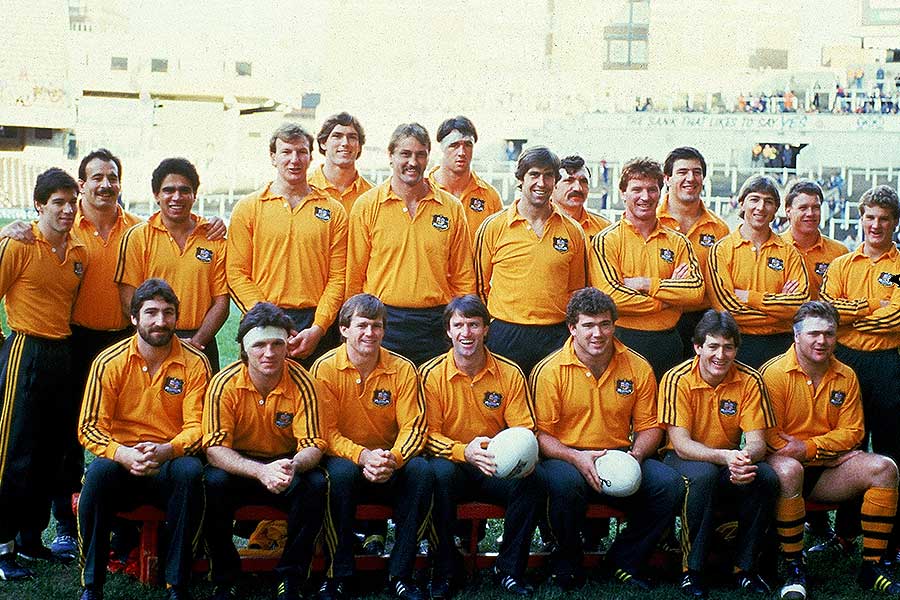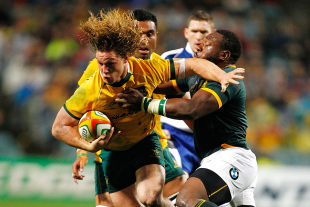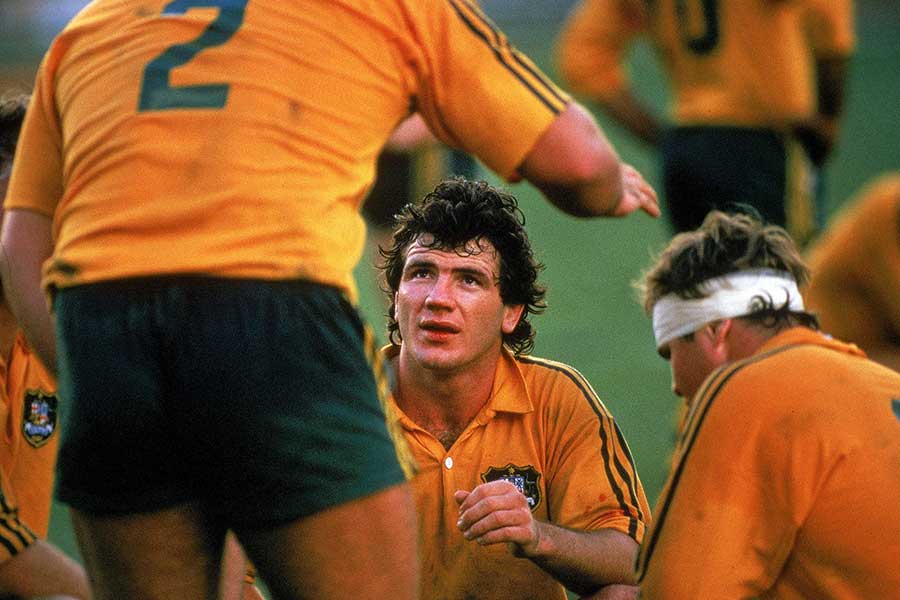|
Greg Growden
So, how good were the 1984 Wallabies?
Greg Growden
November 13, 2014

1984 ... how many 2014 Wallabies would make the Grand Slam-winning team © Getty Images
Enlarge
Members of the illustrious 1984 Wallabies Grand Slam team will assemble in Sydney on Friday for a 30-year anniversary lunch. There will be plenty of big noting, sledging of each other's physiques, brutal comparisons of hairlines, and much reveling about Australian Rugby's most acclaimed touring team. So many Australian rugby enthusiasts first developed their love of the game watching the exploits of the 1984 team as it merrily conquered England, Ireland, Wales and Scotland playing the most dazzling of football brands. There will also be an edge to the function, especially as the 1984 coach Alan Jones has in recent weeks on his Sydney radio program taken aim at the Australian Rugby Union, including its chairman, Michael Hawker, one of the Grand Slam tour playing members. Jones has not held back in his criticism of the ARU - and Hawker has been firmly in his sights, especially over the abysmal handling of the Ewen McKenzie-Di Patston-Kurtley Beale imbroglio. Then again, as one Grand Slam team-mate said of Hawker, known as The Lord, this week: "He's in denial anyway … and will just be his usual oblivious self- brushing the criticism away like a fly." Undoubtedly, at the luncheon, there will be comparisons between the past and the present - and whether any of the current Wallabies now in France on their European tour would have made the Grand Slam team. To get in first, I will just say that the power remains with the past. Of the Wallabies line-up that defeated Wales in Cardiff last weekend, just four players - Michael Hooper, Israel Folau, Adam Ashley-Cooper and Tevita Kuridrani - are of the standard required to make the Grand Slam squad. Hooper, Folau and Ashley-Cooper would be in contention for a starting XV spot, while Kuridrani is a sturdy candidate for the reserves bench. But none would be walk-up starts to make the 1984 run-on side. While Folau has enormous credentials as a fullback, I still doubt that Jones would pick him at No 15 ahead of his 1984 star Roger Gould. Gould was such a crucial element to that Grand Slam ensemble, with his reliability under the high ball, great booming kick down field that often dragged the Wallabies out of trouble, and understanding when to chime into the backline, making him one of Australian rugby's best No.15s. Waltzing wallabies
© Getty Images
Folau could sneak in be on the wing. While David Campese was the master on one 1984 wing, the other was shared by Brendan Moon, Matt Burke and Peter Grigg. Folau is certainly a match for at least two of those three wingers. Moon, who had to go home after the England Test because of a broken arm, was a class above. Ashley-Cooper, the most reliable of team-men who can fit so many backline roles, would also be a credible wing candidate. No.13 is Ashley-Cooper's favoured position, but Andrew Slack still has the edge there, due to his exemplary captaincy during the Grand Slam series. A vastly under-rated centre, Slack remains among the top five Australia captains of all time - deeply admired by his team-mates and respected by his opponents for his ingenuity and gentlemanly approach. Slack was a proper leader. Kuridrani has really matured as a No.13 in recent months, and he would certainly have been hovering near Test selection if he had been around 30 years ago. The current 9-10-12 falls deep within the shadow of the mighty combination of Nick Farr-Jones, Mark Ella and Michael Lynagh. The most revealing of all is the fact that only one current Australia forward is of the required calibre. And therein lies the problem for the current team with the 2015 Rugby World Cup looming within 12 months; the 2014 Wallabies pack is way off being of World Cup title quality. 
Michael Hooper would be a worthwhile addition to the 1984 back-row
© Getty Images
Enlarge
The 1984 Wallabies transformed Australian forward play. Jones, along with his wily assistant coach, Alex Evans, worked diligently in transforming a pack, which had traditionally been criticised for being cream puffs, into the most effective of weapons. They boasted one of the most effective of front-rows, involving three astute scrum tacticians in Andy McIntyre, Tom Lawton and Enrique 'Topo' Rodriguez, who had recently arrived from Argentina and was teaching his eager-to-learn colleagues every trick from the Pumas pack playbook. A highlight of the Grand Slam tour came against Wales in Cardiff, where the Australian eight initiated a move called 'Samson' that saw them shove as one and plough the locals back over their tryline, enabling No.8 Steve Tuynman to jump on the ball for a pushover try. Compare that to last weekend's efforts, again against the Welsh, when the Wallabies pack suffered the indignity of a penalty try awarded against them when they repeatedly fell apart under their own sticks. And penalty tries have become a recent regular Wallabies occurrence. As effective was the Wallabies' second-row combination. Steve Cutler was the Skylab winning any lineout throw that went his way, while Steve Williams provided the muscle. They were certainly a far more formidable unit than the current Wallabies lock combination that seriously lacks starch. 
Chris Roche provided mongrel in the Grand Slam back-row © Getty Images
Enlarge
The 1984 back-row is also superior. Tuynman provided the finesse, and Simon Poidevin, Chris Roche and David Codey the mongrel. The current Australia captain - Hooper - would fit in well with that mob. He is of the same calibre. Hooper and Poidevin are so similar. Fearless. But even the man known as 'King' would have to admit that Hooper's handling skills might just shade his. After all former Wallabies forward and ARU official Peter Crittle once compared the King to Venus de Milo. Nonetheless a Hooper-Poidevin flanker combination is something to drool over. As for a scoreline if the 2014 Wallabies faced the 1984 Wallabies … 2014 Wallabies 21-19 1984 Wallabies (But only because most of the losing line-up haven't played for a quarter of a century or so.) © ESPN Sports Media Ltd
|
Live Sports
Communication error please reload the page.
-
Football
-
Cricket
-
Rugby
-
- Days
- Hrs
- Mins
- Secs
F1 - Abu Dhabi GP
Abu Dhabi Grand Prix December 11-131. Max Verstappen ()
2. Valtteri Bottas (Mercedes)
3. Lewis Hamilton (Mercedes)
4. Alexander Albon ()
5. Lando Norris ()
6. Carlos Sainz Jr ()
-
ESPNOtherLive >>
Snooker - China Open
Tennis - Miami Open

